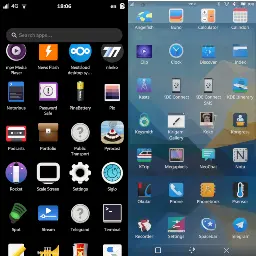Modern Android? More like Modern GNOME - it's called adwaitapod and adwaita is the name of GNOME's style. :-)
No, it's just that when you use a mainline kernel, you're just not reusing all the Android (often user-space) drivers that make cameras work on Android and due to that stuff, starting from drivers for the SoC camera interface to the camera sensor have to be re-implemented. Whether you are on glibc (e.g., on Debian/Mobian) or musl/Alpine does not really matter.
Also, Camera APIs and the whole "desktop Linux" camera stack (think of things like debayering, white-balance) is nowhere near as developed as what Android has (and that, IUC, Ubuntu Touch can reuse on Halium by plumbing things together).
A Pixel 3a may be a good choice. It's older, but not huge—and it's very well-supported in Ubuntu Touch (and Droidian, both use Halium/libhybris to re-use the Android kernel drivers), and also in postmarketOS (mainline Linux 6.9.3 as of this message).
On postmarketOS, camera support is not fully there—the front camera is somewhat supported. Also, Wi-Fi is still a bit annoying, calls only work with headset on postmarketOS, so I would say: Use Ubuntu Touch or Droidian for now, and maybe move on to postmarketOS once it's a bit more solid.
It should be. With zram, I can use similar software even on a 2 GB RAM device somewhat comfortably, unless I open too many tabs in Firefox.
It's somewhat SoC dependent, but the actual feature support depends on auxiliary chips. Of the well-supported phones, only the Shift6mq supports it in hardware - software support on mainline is not there yet though. The Fairphones 4 and 5 also have the feature. I have the 5, and display out works with postmarketOS, but audio support is still lacking, and USB peripherals (e.g., keyboard, mouse) are not supported.
Here's a list of more devices: https://www.uperfectmonitor.com/pages/list-of-smartphones-with-displayport-alt-mode
That said, there are other ways like DisplayLink and or GUD that may enable you to connect a display to a OnePlus 6 or PocoF1 anyway, some people have done it (and left video evidence on social media or YouTube. It definitely requires a customized kernel, and unfortunately, AFAIK the efforts have not been documented/shared (kernel config and necessary packages).
I don't think reporting the USB ID thing to Plasma is useful and will go far - for 99% of users (that use some kind of Android/AOSP) the modus operandi is fine and helpful. With many Android devices and OSes requiring you to do something on the device after plugging it in, testing does not seem to be feasible to me.
There's no need to add the edge repo, as the latest release of mobile-config-firefox should be in v23.12 by now (it's been updated there since my last post). The command I posted does not add the repo, but only uses it for the one package without adding the repo permanently.
I recommend trying to use KDE Connect (or scp, rsync ... another network based way) to send the screenshot from the phone to your other computer instead.
MTP/other file transfer protocols do not (yet?) work with mobile Linux, so this failure is to be expected. It only shows up for connection, because if your device ran Android, it would be an option — AFAIK, Plasma acts this way because of the USB ID of the device.
Also, regarding your main issue: While you can report this to Mozilla, please be aware that Firefox is being "patched" to better work on mobile by https://gitlab.com/postmarketOS/mobile-config-firefox. I suggest you to install the latest, not yet in postmarketOS 23.12 mobile-config-firefox package from edge first by running:
sudo apk del mobile-config-firefox
sudo apk add mobile-config-firefox --repository http://mirror.postmarketos.org/postmarketos/master
While it may not fix every issue possible, it should improve the experience.
Generally yes, but I am just a dumb tech blogger, so what do I know 😀 . I checked the issue tracker, and this issue seems related - I also see that crash, and it might extend beyond upgrades and thus be the source of what you are seeing. If you also see that crash of that service, maybe just upvote the existing issue first or if you can chime in/help out, do that before opening a potential duplicate :-)
As flatpak apps show (correct?) your situation is not different from what I would expect. I installed 23.12 on one of my devices and see a similar behavior. Generally, assuming you did start with a Phosh image or used pmbootstrap and chose phosh as UI (and did not, say, start out with Plasma Mobile and then switched over to Phosh, which can cause weirdness), I think we can safely say that this not just an issue on your end. This is very likely a general issue on 23.12 and edge currently.
Why isn't it fixed already? It sure seems to be difficult, and most "long termers" (extrapolating from my own behavior) likely have given up on using front-ends like GNOME Software or KDE Discover and have become fluent enough with apk and flatpak on the terminal and thus don't contribute to a solution.
As flatpak apps show (correct?) your situation is not different from what I would expect. I installed 23.12 on one of my devices and see a similar behavior. Generally, assuming you did start with a Phosh image or used pmbootstrap and chose phosh as UI (and did not, say, start out with Plasma Mobile and then switched over to Phosh, which can cause weirdness), I think we can safely say that this not just an issue on your end. This is very likely a general issue on 23.12 and edge currently.
Why isn't it fixed already? It sure seems to be difficult, and most "long termers" (extrapolating from my own behavior) likely have given up on using front-ends like GNOME Software or KDE Discover and have become fluent enough with apk and flatpak on the terminal and thus don't contribute to a solution.
It did work on edge at the time of that post (March 2023), and IIRC it may have worked in stable 23.06 (the release right after that post) - I don't have a device still running that to confirm. It since broke again, and it's currently broken in stable and testing (it's definitely broken for me in edge in both Plasma Mobile (KDE Discover) and Phosh/GNOME Mobile (GNOME Software). So don't go to edge because of this, especially not right now.
Nice!
While we‘re at it: do you know if there is any way to get alpine apk visible in gnome software? Its driving me nuts that flatpak is visible and apk which is a lot of stuff can only be installed through cli.
It's a long standing issue, for context I recommend reading https://blogs.gnome.org/pabloyoyoista/2023/03/05/gs-and-pmos-a-bumpy-road/
Without any further configuration, might as well as add that to your edited paraphrased quote.
Please correct me, but AFAIK, necessary configuration of flatpak (e.g., configuring remotes) depends more on the distribution than the architecture (as long as the architecture is supported at all, that is - so x86_64 or aarch64 AFAIK).
Your lengthy explanation of flatpak doesn’t seem to be postmarketos related.
Sure? https://gitlab.com/postmarketOS/pmaports/-/merge_requests/4820 And does it hurt to mention differences in software support between x86_64 and aarch64? I would see your point if I had talked at length about Snaps. ;-)
I was referring to "Flatpak [...] is currently only working as expected on x86_64" is ... if not false, then far too easy to misunderstand. Flatpak works just as well on aarch64 for (at least) hundreds of apps. The software that's not available on, e.g., flathub for aarch64 (but is available for x86_64) in most cases is not available (in compiled form) for aarch64 at all — because it is proprietary with vendors not caring about aarch64, or ... just is electron-based ;-}.
It's not Flatpak, it's the entire aarch64 software ecosystem that's lacking here. Stating "Linux on aarch64 has less available software than x86_64, which is especially so for proprietary software" would have been a far better statement.
Alpine edge testing apps are in postmarketOS edge. So yeah, not all of them make it to stable, but quite a few do:
For software listed on https://linuxphoneapps.org/ the count is as follows: Alpine 3.19: 160 Alpine edge: 198
(Source: https://linuxphoneapps.org/packaged-in/)
The difference should be mostly the apps that have not made it beyond testing, yet.
Please note that you can also try installing testing apps on stable by apk add PKGNAME --repository=http://dl-cdn.alpinelinux.org/alpine/edge/testing, or, maybe as more safe way of doing this, use distrobox, install alpine:latest in it, and changing /etc/apk/repositories/ to make it edge instead of 3.19.
You can also try to build some software that's not packaged by coming up with your own APKBUILDs, I did so a while ago on https://framagit.org/linmobapps/apkbuilds, maybe the notes I left there can be helpful to you.
Regarding Wikis: They always get stale, so clarifications and additions are surely welcome!
This is ... a bit false. Flatpaks do show in GNOME Software on other distributions, and while not every app on Flathub supports aarch64, many do. I somehow managed to not have a with postmarketOS stable and Phosh here right now (I misplaced my PinePhone that runs that combination), so I can't say if it would work for me. It definitely works on other distributions, though; but there's always the added difficulty of imperfect app metadata making it a game of luck to recognise a mobile friendly app as such.
That said, you can always install packages from the terminal, flatpak (flatpak install ...) or apk (apk add ...) or otherwise. To find apps to look at, maybe LinuxPhoneApps.org can be useful.
This sounds more like a network problem, maybe something on your end or that one of the repos was temporarily unreachable (usually it's the postmarketOS repo for me in such situations). I recommend running sudo apk update in situations like this and reading through the output. Depending on which repo is unreachable (= if it's one of the alpine repos) it may be a better idea to delay upgrading.
It definitely has nothing to do with the device being dropped from main to community — both categories mean that the device is served by stable.
Hope this helps!
I've been told that PinePhone 2 is not happening this year. (If AllWinner will continue to supply A64 SoCs, it might take even longer.)
Regarding SoC, the likely/obvious candidate is RK3566 - but we'll have to wait and see for the when and how. (I, personally, would love to see a PinePhone V - think PineTab V, but as a phone).
PineTime: It has nice companion apps on Mobile Linux, but I went back to my Pebble Time Steel - the always on display matters to me.
Yeah man, I think the article I initially read about PP Mobian situation was this one here just for reference if I am even remembering right – https://blog.mobian-project.org/posts/2023/09/30/paperweight-dilemma/
Someone stepped up (see https://blog.mobian.org/posts/2024/01/08/highlights-of-2023/ and afaik a-wai also mentioned this at fosdem (https://fosdem.org/2024/schedule/event/fosdem-2024-3290-towards-a-bright-future-with-mobian-/), also long standing issues like the out-of-tree-WiFi/BT driver are being worked on currently.
Regarding Beepy: I really tried, but ... compared to that, PinePhone was easy to get to a somewhat works state in mid 2020. See https://linmob.net/enter-beepy-esc/#flaws
A blog post about FOSDEM 2024's 'The Linux Phone Apps Ecosystem' talk

We're back with another overdue update, marking our five year anniversary as well as the official Chimaera release. Apart from the upgrade to Chimeara / Bullseye (from Beowulf / Buster), here are...
Congrats to the project, this is great progress!
Three years and one day ago, the first Weekly Update on GNU-like mobile Linux, then dubbed LinBits, was published. A lot has happened since, and this celebratory blog post is an attempt to summarize highlights on a per-months basis. I'd like to thank Blort for the idea and contributing so much to th...

I figured this might be worth sharing :)